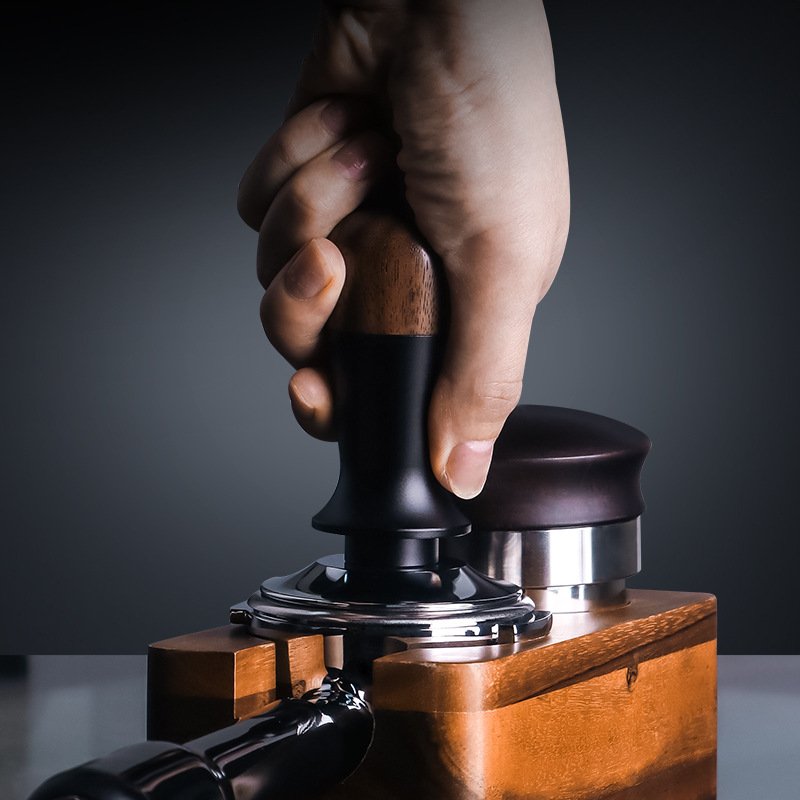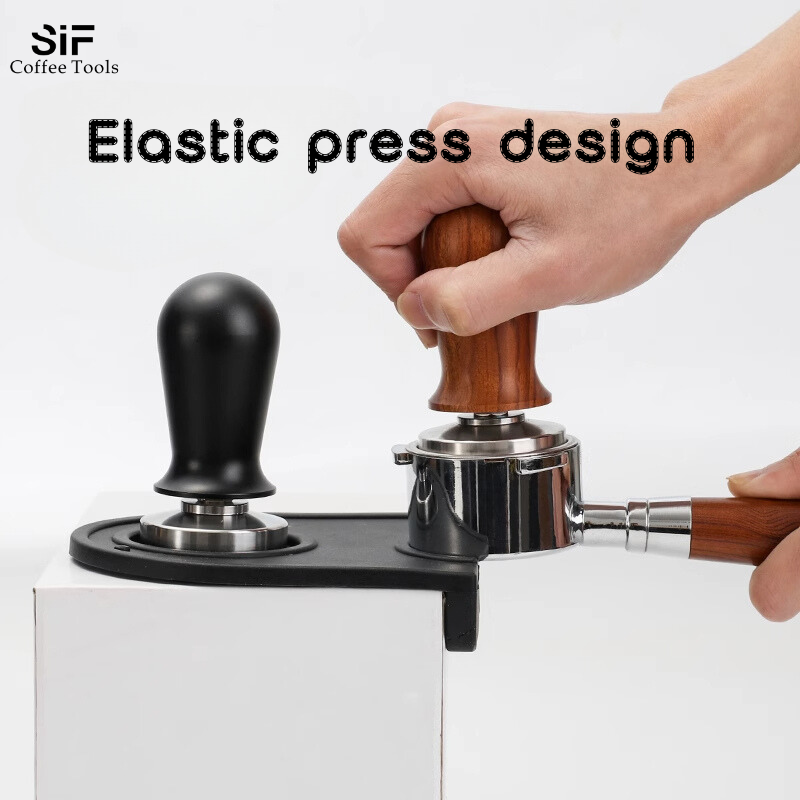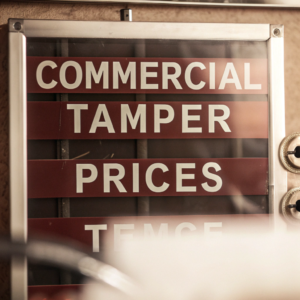Choosing the wrong tamper can devastate your espresso quality. I've seen cafes waste thousands on beans while their baristas struggle with inconsistent shots due to improper tamping equipment.
Commercial-grade tampers must precisely match your portafilter diameter with tolerance less than 0.5mm. The right tamper provides consistent pressure distribution, improves workflow efficiency, and ensures repeatable extractions across multiple baristas, ultimately protecting your coffee quality and reputation.

After supplying tampers to specialty cafes for over eight years, I've learned that tamper selection directly impacts your bottom line. Let me guide you through the essential considerations for choosing commercial-grade tampers that will stand up to your busiest days while maintaining exceptional quality in every cup.
How Does Tamper Size Impact Espresso Extraction?
Precision matters when applying pressure to coffee grounds. I've seen cafes' extraction yields drop by 15% simply because they used tampers with even a 1mm gap to the basket wall.
The tamper diameter must match your portafilter baskets with a tolerance of 0.1-0.2mm for optimal results. Standard commercial diameters include 58mm, 58.5mm, 57mm, 53mm, and 49mm, with 58-58.5mm being most common in professional settings. This precise fit ensures even distribution of pressure across the entire coffee puck.

When selecting commercial tampers, precision engineering becomes critical for consistent quality. A properly fitted tamper ensures even water flow through the coffee puck, preventing channeling (water finding the path of least resistance) which causes under-extraction in some areas and over-extraction in others.
Optimal Tamper Sizing for Common Commercial Machines
| Machine Brand | Standard Basket Size | Recommended Tamper Size | Notes |
|---|---|---|---|
| La Marzocco | 58mm | 58.4-58.5mm | Slight oversizing improves edge compaction |
| Rancilio | 58mm | 58.0-58.3mm | Standard commercial fit |
| Slayer | 58mm | 58.5mm | Precision fit recommended |
| Nuova Simonelli | 58mm | 58.3-58.5mm | Higher tolerance ranges |
| Lelit | 57mm | 57.0-57.3mm | Exact sizing important |
| Breville/Sage | 54mm | 53.5-54.0mm | Often proprietary sizing |
The relationship between basket tolerance and tamper size directly influences extraction consistency. I've conducted pressure distribution tests1 with various sizing combinations and found that under-sized tampers leave a ring of loose grounds around the edge, creating a high-risk zone for channeling. Conversely, oversized tampers can damage baskets or create excessive resistance during tamping. A precision-fit tamper should slide into the basket with minimal resistance while leaving no visible gap between tamper edge and basket wall.
What Types of Commercial Tampers Work Best in Busy Cafes?
Serving hundreds of customers daily exposes equipment weaknesses quickly. I watched a famous Dubai cafe switch tampers three times until finding one that maintained consistency through their 500+ daily shots.
For high-volume operations, spring-loaded (calibrated) tampers provide consistent pressure (typically 30lbs) regardless of barista technique. Manual tampers offer simplicity but require skilled operators. Automatic tamping stations maximize throughput and consistency but require significant counter space and investment.

Commercial environments demand tamping equipment that balances efficiency with consistency. Traditional manual tampers remain popular for their simplicity and tactile feedback, but they introduce significant variability between baristas. Spring-loaded calibrated tampers address this concern by providing consistent pressure with every tamp, which is particularly valuable in cafes with multiple staff members or high turnover.
Comparing Commercial Tamper Mechanisms
| Tamper Type | Consistency | Speed | Learning Curve | Cost | Maintenance |
|---|---|---|---|---|---|
| Manual | Lower | Moderate | High | $40-150 | Minimal |
| Spring-Loaded | High | Moderate | Low | $100-250 | Periodic spring check |
| Automatic | Very High | Very Fast | Minimal | $600-2,500 | Regular cleaning/calibration |
The operational realities of your specific cafe should dictate your selection. For specialty cafes prioritizing craft, manual tampers provide the artisanal touch that customers appreciate. For busy downtown locations serving hundreds of customers daily, automatic tamping stations dramatically improve throughput while maintaining consistency. Medium-volume operations often find spring-loaded tampers provide the ideal balance – offering consistency without significant investment or training requirements.
I've supplied tampers to cafes across all three categories and find that most successful operations gradually migrate toward more automated solutions as volume increases. However, proper training remains essential regardless of technology level.
How Do Materials and Design Affect Commercial Tamper Performance?
Material choice impacts more than aesthetics. At a specialty cafe in Madrid, we replaced their aluminum-based tampers with stainless steel models, immediately reducing complaints about inconsistent shots by 30%.
Professional-grade tampers use food-safe stainless steel (304 or 316 grade) for the base with ergonomic handles made from turned wood, anodized aluminum, or composite materials. Weight distribution matters – a balanced tamper (typically 400-600g) reduces wrist fatigue during repetitive use in commercial settings.

The design considerations for commercial tampers extend beyond simple functionality into ergonomics and operational efficiency. In high-volume environments, baristas may perform hundreds of tamping actions per shift, making handle design and weight distribution critical factors in preventing repetitive strain injuries.
Material Impact on Commercial Performance
| Component | Material Options | Commercial Benefits | Considerations |
|---|---|---|---|
| Base | Stainless Steel 304/316 | Durability, food safety, consistent weight | Requires proper finishing to avoid coffee sticking |
| Base | Titanium | Lighter weight, premium feel | Significantly higher cost, limited benefit |
| Handle | Hardwood (Walnut, Maple) | Aesthetically pleasing, comfortable grip | May degrade with excessive moisture exposure |
| Handle | Anodized Aluminum | Durable, moisture resistant, customizable | Can become cold to touch in air-conditioned settings |
| Handle | Composite/Resin | Very durable, consistent performance | Less premium aesthetic |
The shape of the base also significantly impacts tamping performance. Flat bases remain the industry standard for their simplicity and consistency, while convex bases (slightly curved outward) can help prevent edge channeling by directing more pressure toward the portafilter edges. Some specialty tampers feature multiple surfaces or adjustable depth collars to accommodate different dose amounts.
Weight distribution between handle and base affects tamping technique and consistency. Heavier bases (often 300-350g) provide momentum that helps maintain even pressure, while lighter designs require more controlled force application. The balance point should ideally sit where the handle meets the base, creating a natural pivot point for the tamping motion.
What Ergonomic Features Matter in Commercial Tampers?
Barista injuries cost cafes thousands in lost productivity. During a consultation in Dubai, I met a cafe owner who had three baristas develop wrist issues from poorly designed tampers in a single year.
Ergonomically designed tampers feature comfortable handles with proper diameter (usually 30-38mm) and height (80-100mm) proportions. Advanced designs incorporate pressure-distributing features and wrist-neutral angles. For high-volume operations, palm tampers reduce wrist strain by shifting force application to larger muscle groups.

The physical demands of professional tamping are often underestimated when selecting equipment. A standard commercial barista may perform the tamping motion 300+ times daily, making ergonomic considerations essential for long-term staff health and consistency.
Ergonomic Design Elements and Their Impact
| Design Element | Optimal Specification | Impact on Performance |
|---|---|---|
| Handle Diameter | 30-38mm (adjustable for hand size) | Promotes neutral wrist position, improves grip |
| Handle Height | 80-100mm | Allows for proper leverage without excess material |
| Base Weight | 300-350g | Provides momentum for consistent pressure |
| Total Weight | 400-600g | Balances control with fatigue reduction |
| Grip Material | Textured, moisture-resistant | Prevents slipping with sweaty hands |
| Handle Shape | Slightly contoured | Accommodates natural hand position |
Beyond basic dimensions, advanced ergonomic tampers2 incorporate design elements specifically addressing commercial usage patterns. Palm tampers completely redesign the force application method, using a flat upper surface against which the barista presses with their palm rather than gripping with fingers. This technique involves larger muscle groups and places the wrist in a more neutral position.
Pressure-distributing systems3, either through mechanical springs or innovative handle designs, can also significantly reduce strain. Some commercial tampers now incorporate adjustable height features4 to accommodate baristas of different statures, ensuring everyone can maintain proper posture during the tamping motion.
How Much Should Cafe Owners Budget for Commercial Tampers?
Quality and productivity have real costs. A cafe owner in Spain initially balked at investing €120 per tamper, but realized their value after calculating the cost of inconsistent extractions and wasted coffee.
Budget at least $100-150 per manual tamper for commercial environments, $150-250 for quality calibrated (spring-loaded) models, and $600-2,500 for automatic tamping stations. Factor in having backups (1 tamper per 2 workstations minimum) and periodic replacement of moving parts in calibrated models.

Investment in proper tamping equipment should be viewed within the context of overall quality control and operational efficiency. The direct cost of tampers represents a small fraction of a cafe's equipment budget but can have disproportionate impact on consistency and product quality.
Commercial Tamper ROI Considerations
| Tamper Type | Initial Investment | Lifespan | Training Required | Impact on Consistency | Throughput Effect |
|---|---|---|---|---|---|
| Basic Manual | $40-80 | 3-5+ years | Extensive | Highly variable | Neutral |
| Premium Manual | $100-150 | 5-10+ years | Extensive | Variable | Neutral |
| Calibrated | $150-250 | 3-5 years | Moderate | Consistent | Slightly improved |
| Automatic Station | $600-2,500 | 3-7 years | Minimal | Very consistent | Significantly improved |
When calculating return on investment, consider the hidden costs of inconsistent tamping: wasted coffee from poorly extracted shots that must be remade, extended training periods for new staff, customer dissatisfaction from inconsistent product, and potential repetitive strain injuries. Premium tampers often pay for themselves within months through reduced waste alone.
For cafes serving specialty coffee at premium prices, tamper quality directly impacts your ability to deliver on quality promises. I've found that specialty cafes typically realize the greatest benefit from calibrated tampers, striking the optimal balance between craft presentation and consistency, while very high-volume operations benefit most from fully automatic solutions despite their higher initial investment.
Conclusion
Choosing the right commercial tamper involves balancing precision, ergonomics, durability, and operational needs. Invest in quality tampers that match your portafilter exactly, consider ergonomic designs to protect your baristas, and select models that ensure consistency across your team.
-
Understanding pressure distribution tests can help improve your coffee extraction techniques and consistency. ↩
-
Explore how advanced ergonomic tampers can enhance barista efficiency and comfort, leading to better coffee quality. ↩
-
Learn about pressure-distributing systems and their role in minimizing strain, improving barista health and productivity. ↩
-
Discover how adjustable height features can accommodate diverse barista statures, promoting better posture and efficiency. ↩




